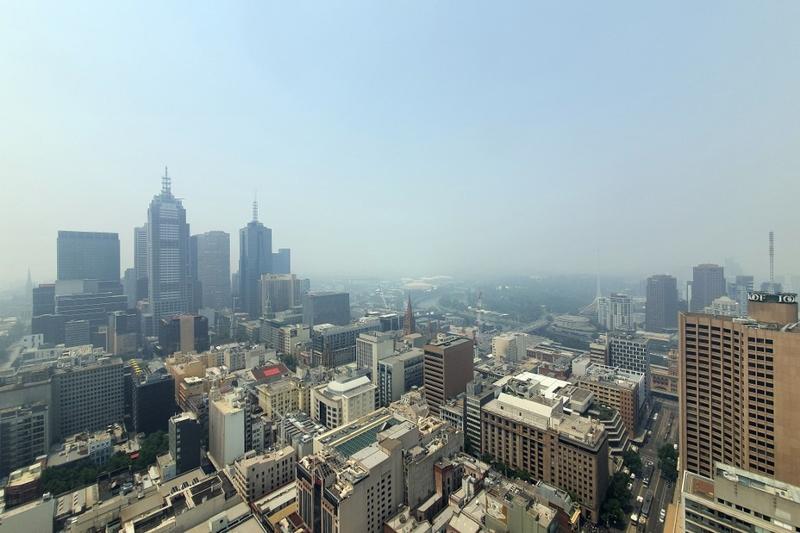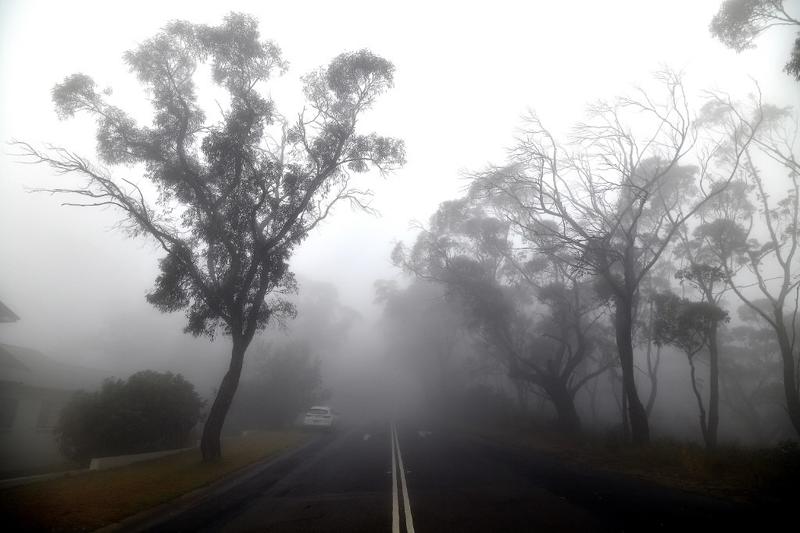 A bushfire burns near the town of Bumbalong, south of Canberra on Feb 2, 2020. (PETER PARKS / AFP)
A bushfire burns near the town of Bumbalong, south of Canberra on Feb 2, 2020. (PETER PARKS / AFP)
BUCHAN, Australia - Returning from a morning feeding his sheep, Jeff McCole, a 70-year-old farmer, paused to take in the bittersweet scene - a few droplets of rain falling onto the remains of his fire-ravaged home.
“Nothing like the sound of rain on a tin roof,” he said, as he scanned the residue of a lifetime of memories scattered before him.
By the old front door was a charred metal toy truck his grandchildren once raced down the verandah. Under the remains of the tin roof, a collection of books, his wife’s “pride and joy”, had been reduced to layers of feathery ash. And out back, the skeleton of a Valencia orange tree, planted by his mother 65 years ago, was now laden with baubles of charcoaled fruit.
Seasonal bushfires have struck Australia in a way like never before, making for months of monster blazes and toxic haze, and fuelling a polarizing debate over climate change
ALSO READ: Australia receives a bittersweet fire reprieve with floods, cyclone
Seasonal bushfires have struck Australia in a way like never before, making for months of monster blazes and toxic haze, and fuelling a polarizing debate over climate change.
But in Buchan, a conservative-voting farming town in Victoria state that is home to the McCole farm, most locals said they believed the catastrophic fires had nothing to do with global warming.
Climate change was “a load of crap”, said McCole, an idea pushed by city folk with “no experience in the bush” and no understanding of Australia’s punishing, cyclical climate.
“We’ve had severe droughts and everything like that, 70 years ago,” said McCole, a Vietnam war veteran with sky-blue eyes. “It just keeps going around in circles. If you wait, it’s going to change.”
RISING RISKS
For decades scientists have warned that climate change would increase the risk of extreme bushfires in Australia. This year, there was the perfect storm - record-breaking drought and heat coalescing on tinderbox land.
 Smoke from the Victoria bushfire fills the sky over Melbourne city on Jan 14, 2020. (MARK PETERSON / AFP)
Smoke from the Victoria bushfire fills the sky over Melbourne city on Jan 14, 2020. (MARK PETERSON / AFP)
Before rains slowed their spread in recent days, the fires had burned through almost 12 million hectares, destroyed more than 2,800 homes, and claimed the lives of 33 people. An estimated one billion native animals are also believed to have died.
Australia has one of the world’s highest carbon footprints per capita and is one of the largest exporters of coal and gas, making successive governments reluctant to adopt climate change policies they say could undermine the economy.
But with these unprecedented bushfires, the government has come under increased pressure from environmental groups, scientists and broader swathes of the Australian public to address the climate change issue.
“People are more fearful of the future because they glimpsed the future this summer,” said Lesley Hughes, a professor and climate scientist at Macquarie University. “I think it has been really wounding of the Australian psyche.”
Polling by the Australia Institute, a Canberra think tank, in January found that 79 percent of Australians said they were concerned about climate change, up five percentage points from last July, with 47 percent “very concerned”, a jump of 10 points.
 Thick fog mixed with bushfire smoke fills the sky in the Ruined Castle area of the Blue Mountains, some 75 kilometres from Sydney, on Jan 11, 2020. (SAEED KHAN / AFP)
Thick fog mixed with bushfire smoke fills the sky in the Ruined Castle area of the Blue Mountains, some 75 kilometres from Sydney, on Jan 11, 2020. (SAEED KHAN / AFP)
But there remains widespread scepticism that the severity of the fires is due to climate change, with many conservative politicians and media suggesting that factors such as arson, the length of cyclical droughts or poor management of flammable vegetation are more responsible.
Prime Minister Scott Morrison, who had previously declined to discuss the link between climate change and the fires, recently acknowledged the connection, but said his priority was managing the economic impact.
Morrison last week cited “hazard reduction” - which includes the practice of controlled burns to reduce the amount of flammable vegetation in the bush, as a key to mitigating fires in the future, saying it was just as important as reducing emissions.
Climate scientists say that the bigger problem for Australia are longer droughts and increasingly hot summers.
The issue of controlled burns is a deeply emotional one in Buchan, where at least 20 homes were lost in the fires that struck in December.
“Climate change or not,” said Donald Graham, a farmer who survived the fires huddled in his concrete bunker with a stack of cheese and vegemite sandwiches. “These fires were a disaster waiting to happen.”
A DEATH TRAP
The road from Melbourne to Buchan winds past a series of small country towns, pie shops and historic churches and, after a weekend of rain, verdant green fields with dairy cows.
But closer to Buchan, population 385, the road is eerily burnt out, lined by rows of black tree trunks sticking out of ashy ground.
When the bushfires hit the town on Dec 30, they roared in on three fronts with a ferocity that no locals had ever seen.
For more than a month, fires had raged ominously in nearby bushland, finally bellowing in with “one heck of a red glow”, McCole said.
From the verandah of his home, nestled on a 400-hectare property of rolling hills, gum trees and Merino sheep, he watched a giant orange plume crest over the hill and rain down fiery embers.
“We only had ten minutes to get out and I think that was the best call I ever made,” he said with a wry laugh. “It was a death trap.”
The town of Buchan is a single main street with a general store and a pub - the kind of place where locals have time to discuss the pressing issues of the day with a stranger.
“The issue of climate change and the fire is a dead duck as far as I’m concerned,” said Graham, an animated 68-year-old cattleman with a shock of gray hair. “What is the most significant thing, is the changing structure of the forest.”
Minutes before he watched his house go up in flames from the peephole of his bunker, Graham raced inside to grab a picture from the wall, a colonial lithograph featuring the magnificent valley below overlooking the confluence of the Snowy and Buchan rivers.
The picture is significant because it shows how much the land has changed, he said.
“We’ve got an accumulation of vegetation. Our area was burned 50-70 years ago and it has not burned since, and at some point it will burn,” he said. “It just needs a few things to come together, a few dry years and some lightning and neither of those are peculiar to the Australian landscape.”
His neighbor John Coates, a 76-year-old cattle farmer, said that decades of vegetation growth had turned the land into a “timebomb”.
Walking through their property overlooking the Snowy River National Park, Coates and his wife Janice shook their heads at the destruction - bald, blackened hills and the devastated gorge below, once filled with ferns, lyrebirds and platypus in the creek.
Many locals in Buchan recall the days they would carry a box of matches in their pockets so they could carry out their own hazard-reduction burns.
But regulations subsequently put in place aimed at protecting state forests and bushland mean they are now dependent on government agencies for carrying out controlled burns.
For years, local farmers had urged the government to carry out burns to reduce the “fuel load”, or the accumulation of trees, underbrush and dry grass that can turn a small bushfire into an inferno, Coates said. But it never happened.
Chris Hardman, the chief fire officer for Forest Fire Management Victoria, said in a statement to Reuters that his agency had planned to burn 246,396 hectares of the state’s public land last year, but was “unable to do so because it would have been unsafe”.
Scientists also say the drought and increasingly hot weather means there are fewer days that vegetation can be safely burned.
Commenting on the issue in New South Wales, Richie Merzian, climate and energy program director at the Australia Institute, said it was not a case of failing to implement techniques that had worked in the past, but that such techniques were “insufficient to address the scenario now”.
“You can’t blame the dry conditions and say it has no relevance to climate change,” he said. “It’s a combination of many different climatic changes that can be linked back to the overall trend.”
SEASONS ‘OUT OF SYNC’
In Buchan, not everyone in town was averse to talk of climate change - a few spoke of the seasons being “out of sync”, the lack of rain or the demise of fragrant yellow box flowers in the valley.
But the fires have mainly reinforced pre-existing views and gripes, reflecting the polarizing rhetoric of the national climate change debate.
Last November, Australia’s Deputy Prime Minister Michael McCormack - who heads the party that won in the electorate that includes Buchan - described climate change concerns as those held by “inner-city raving lunatics”.
READ MORE: Australia's capital braces as hot, windy conditions fuel bushfires
That messaging appeared to resonate in Buchan, far from the skyscrapers and the lights of Melbourne or Sydney, with a strong sense that people here were living far greener lives.
“They blame our cows,” said McCole, referring to recent attention on the earth-warming methane produced by belching or flatulent cattle. But, he said, “they are all jumping on electric trains and cars and god knows what in the city and there are millions of them, flying around the world in jumbo jets.”
“It takes a good cow to put out that many emissions,” he said. “I can tell ya.”


